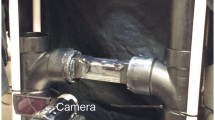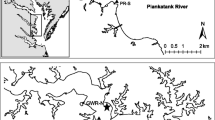Abstract
The interaction of flowing water with reef topography creates a continuum of flow microhabitats that can alter species distributions directly via transport of organisms or propagules, or indirectly by modulating the availability of critical resources. To examine how water flow affects the distribution and feeding performance of two species of planktivorous tube blennies (Chaenopsidae), flow speed and turbulence were measured within the feeding areas of Acanthemblemaria spinosa and A. aspera at three sites within Glover’s Reef, Belize. Although co-occurring, A. spinosa occupies topographically high locations (e.g., upright coral skeletons) while A. aspera occupies topographically low shelters in the coral pavement. Boundary layer theory predicts that A. spinosa should experience higher flow (and a higher flux of planktonic food) relative to A. aspera; however, complex topography and oscillatory flow require that this prediction is tested directly in the field. Within each site, the flow experienced by A. spinosa was, indeed, faster and more turbulent than that experienced by A. aspera at site-specific intermediate wave heights. When waves were small, gentle velocity gradients produced similar flows for the two species. When waves were high, flow was uniformly fast through the water column due to thinning of the benthic boundary layer. Plankton availability was similar for the species, with the exception of a greater abundance of harpacticoid copepods at the shelters of A. aspera. Quantitative behavioral observations suggest that the foraging strategies employed by the two fishes exploit the prevailing hydrodynamic conditions. For example, A. spinosa, the stronger swimmer of the two, attacks nearly 100% of the time in the water column where it can exploit the higher flux of plankton associated with faster flows, while A. aspera attacks primarily toward the reef surface where currents are likely to be slower and it can exploit more abundant benthic prey.








Similar content being viewed by others
References
Bellwood DR, Wainwright PC (2001) Locomotion in labrid fishes: implications for habitat use and cross-shelf biogeography on the Great Barrier Reef. Coral Reefs 20:139–150
Clarke RD (1989) Population fluctuation, competition and microhabitat distribution of two species of tube blennies, Acanthemblemaria (Teleostei: Chaenopsidae). Bull Mar Sci 44:1174–1185
Clarke RD (1992) Effects of microhabitat and metabolic rate on food intake, growth and fecundity of two competing coral reef fishes. Coral Reefs 11:199–205
Clarke RD (1994) Habitat partitioning by chaenopsid blennies in Belize and the Virgin Islands. Copeia 1994:398–405
Clarke RD (1996) Population shifts in two competing fish species on a degrading coral reef. Mar Ecol Prog Ser 137:51–58
Clarke RD (1999) Diets and metabolic rates of four Caribbean tube blennies, genus Acanthemblemaria (Teleostei: Chaenopsidae). Bull Mar Sci 65:185–199
Clarke RD, Buskey EJ, Marsden KC (2005) Effects of water motion and prey behavior on zooplankton capture by two coral reef fishes. Mar Biol 146:1145–1155
Clarke RD, Finelli CM, Buskey EJ (2009) Water flow controls distributions and feeding behavior of two co-occurring coral reef fishes: II: Laboratory measurements. Coral Reefs. doi:10.1007/s00338-009-0479-7
Denny MW (1988) Biology and the mechanics of the wave-swept environment. Princeton University Press, Princeton, NJ
Depczynski M, Bellwood DR (2005) Wave energy and spatial variability in community structure of small cryptic coral reef fishes. Mar Ecol Prog Ser 303:283–293
Forrester GE (1991) Social rank, individual size and group composition as determinants of food consumption by humbug damselfish, Dascyllus aruanus. Animal Behavior 42:701–711
Fulton CJ, Bellwood DR (2005) Wave induced water motion and the functional implications for coral reef fish assemblages. Limnol and Oceanogr 50:255–264
Fulton CJ, Bellwood DR, Wainwright PC (2005) Wave energy and swimming performance shape coral reef fish assemblages. Proc R Soc B 272:827–832
Gardella DJ, Edmunds PJ (2001) The effect of flow and morphology on boundary layers in the scleractinians Dichocoenia stokesii (Milne-Edwards and Haime) and Stephanocoenia michilini (Milne-Edwards and Haime). J Exp Mar Biol Ecol 256:279–289
Genin A, Yahel G, Reidenbach MA, Monismith SG, Koseff JR (2002) Intense benthic grazing on phytoplankton in coral reef revealed using the control volume approach. Oceanography 15:90–96
Gischler E, Hudson JH (1998) Holocene development of three isolated carbonate platforms, Belize, Central America. Mar Geol 144:333–347
Glynn PW (1973) Ecology of a Caribbean coral reef. The Porites reef-flat biotope: Part II. Plankton community with evidence for depletion. Mar Biol 22:1–21
Hamner WM, Carleton JH (1979) Copepod swarms: attributes and role in coral reef ecosystems. Limnol and Oceanogr 24:1–14
Hamner WM, Jones MS, Carleton JH, Hauri IR, Williams DM (1988) Zooplankton, planktivorous fish, and water currents on a windward reef face: Great Barrier Reef, Australia. Bull Mar Sci 42:459–479
Hearn CJ, Atkinson MJ, Falter JL (2001) A physical derivation of nutrient-uptake rates in coral reefs: effects of roughness and waves. Coral Reefs 20:347–356
Heidelberg KB, Sebens KP, Purcell JE (2004) Composition and sources of near reef zooplankton on a Jamaican forereef along with implications for coral feeding. Coral Reefs 23:263–276
Hobson ES (1991) Trophic relationships of fishes specialized to feed on zooplankters above coral reefs. In: Sale PF (ed) The ecology of fishes on coral reefs. Academic Press, San Diego, CA, pp 69–95
Johansen JL, Bellwood DR, Fulton CJ (2008) Coral reef fishes exploit flow refuges in high-flow habitats. Mar Ecol Prog Ser 360:219–226
Madin J, Black KP, Connolly SR (2006) Scaling water motion on coral reefs: from regional to organismal scales. Coral Reefs 25:635–644
Motro R, Ayalon I, Genin A (2005) Near-bottom depletion of zooplankton over coral reefs: III: vertical gradient of predation pressure. Coral Reefs 24:95–98
Robinson HE, Finelli CM, Buskey EJ (2007) The turbulent lives of copepods: laboratory flume studies of how flow over a coral reef affects their ability to detect and evade predators. Mar Ecol Prog Ser 349:171–181
Roy AG, Biron P, de Serres B (1996) On the necessity of applying a rotation to instantaneous velocity measurements in river flows. Earth Surface Process Landf 21:817–827
Sebens KP, Maney EJ Jr, Witting J (1992) A portable dive operated plankton sampler for near-substratum use. American Academy of Underwater Sciences.
Sebens KP, Grace SP, Helmuth B, Maney EJ, Miles JS (1998) Water flow and prey capture by three scleractinian corals, Madracis mirabilis, Montastrea cavernosa and Porites porites, in a field enclosure. Mar Biol 131:347–360
Shashar N, Kinane S, Jokiel PL, Patterson MR (1996) Hydromechanical boundary layers over a coral reef. J Exp Mar Biol Ecol 199:17–28
Smith-Vaniz WF, Palacio FJ (1974) Atlantic fishes of the genus Acanthemblemaria with description of three new species and comments on Pacific specis (Clinidae: Chaenopsinae). Proc Acad Nat Sci Phila 125:197–224
Trager G, Achituv Y, Genin A (1994) Effects of prey escape ability, flow speed, and predator feeding mode on zooplankton capture by barnacles. Mar Biol 120:251–259
Vogel S (1994) Life in moving fluids. Princeton University Press, Princeton, NJ (467)
Williams SL, Carpenter RC (1998) Effects of unidirectional and oscillatory water flow on nitrogen fixation (acetylene reduction) in coral reef algal turfs, Kaneohe Bay, Hawaii. J Exp Mar Biol Ecol 226:293–316
Yahel G, Post AF, Fabricius K, Marie D, Vaulot D, Genin A (1998) Phytoplankton distribution and grazing near coral reefs. Limnol and Oceanogr 43:551–563
Yahel R, Yahel G, Genin A (2005) Near-bottom depletion of zooplankton over coral reefs: I: diurnal dynamics and size distribution. Coral Reefs 24:75–86
Zar JH (1984) Biostatistical Analysis. Prentice Hall, Englewood Cliffs
Acknowledgments
We would like to thank the lab managers and staff at the Middle Cay Field Station for their expert help, especially our boatmen and dive masters Elmar Avila, Cardinal Andrews, Faygon Villanuevia, and Randolph Nunez. Field support was provided by Carly Gaebe, Benjamin Kessler, and Jora Ehrlich. This work was authorized by a research permit from the Belize Fisheries Department, Ministry of Agriculture and Fisheries, and the University of Texas Institutional Animal Care and Use Committee permit number 04113007. Funding was provided by National Science Foundation Awards OCE-0324724, OCE-0324413, and OCE-0324694/0715271. This paper is contribution number 1488 of the University of Texas Marine Science Institute and publication number 30 of the Wildlife Conservation Society's Glovers Reef Research Station.
Author information
Authors and Affiliations
Corresponding author
Additional information
Communicated by Biology Editor Dr. Mark McCormick
Rights and permissions
About this article
Cite this article
Finelli, C.M., Clarke, R.D., Robinson, H.E. et al. Water flow controls distribution and feeding behavior of two co-occurring coral reef fishes: I. Field measurements. Coral Reefs 28, 461–473 (2009). https://doi.org/10.1007/s00338-009-0481-0
Received:
Revised:
Accepted:
Published:
Issue Date:
DOI: https://doi.org/10.1007/s00338-009-0481-0




